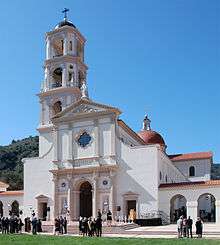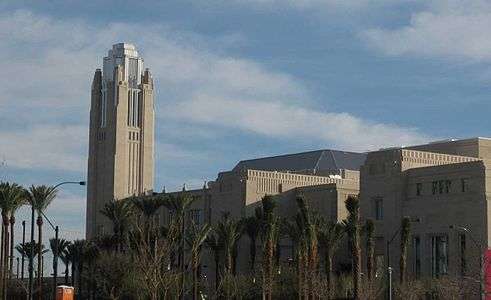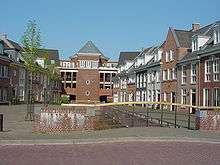New Classical architecture

New Classical architecture is a contemporary movement in architecture that continues the practice of classical and traditional architecture. The design and construction of buildings in these traditions is continuous throughout the twentieth and twenty-first centuries, even as modernist and other post-classical theories of architecture have been more dominant. Since New Classical architecture is not an architectural style and can appear in various forms, contemporary classical buildings might be also, although not correctly, be described with the terms Traditionalism, Neo-Historism (or Historicism/Revivalism), or simply Neoclassical Architecture, implying the continuation of a specific historical style.[1]
Development

At the beginning of the 20th century, historicism and Jugendstil were still dominant styles in Germany. The Austrian architect Adolf Loos criticized his time's architecture as too "grandiloquent" and "opulent", and longed for a complete abandonment of architectural ornaments in his 1910 essay Ornament and Crime.[2] As early as the first major modernist movements like Werkbund and Bauhaus gained momentum in Germany, the desire to continue and develop classical styles sprouted.[3] From 1904 until around 1955 the Heimatschutz style prospered in Germany, which focused on vernacular traditions and can be roughly translated to cultural protection style. Examples of this early new classical style are the Hamburg Museum, the Prinzipalmarkt in Münster and the market square of Freudenstadt. After heavy Allied bombing of Germany in World War II, architects such as Adolf Abel, Roderich Fick, Konstanty Gutschow, Werner March, Paul Schmitthenner, Julius Schulte-Frohlinde, and Rudolf Wolters assisted in the postwar rebuilding of destroyed German cities using Heimatschutz and other traditional design methods. In Britain, architect Raymond Erith continued to design classical houses into the late 1960s and early 1970s. Quinlan Terry, a New Classical Architect who continues to practice, was an employee, later a partner and now the successor of the late Raymond Erith. In the late 1970s several young architects in Europe began challenging modernist proposals in architecture and planning. To broadcast them, Leon Krier and Maurice Culot founded the Archives d'Architecture Moderne in Brussels and began publishing texts and counterprojects to modernist proposals in architecture and planning.[4] It received a boost from the sponsorship of Charles, Prince of Wales, especially with The Prince's Foundation for Building Community.[5]


With the demand for professors knowledgeable in the history of architecture, several PhD programs in schools of architecture arose in order to differentiate themselves from art history PhD programs, where architectural historians had previously trained. In the US, MIT and Cornell were the first, created in the mid-1970s, followed by Columbia, Berkeley, and Princeton. Among the founders of new architectural history programs were Bruno Zevi at the Institute for the History of Architecture in Venice, Stanford Anderson and Henry Millon at MIT, Alexander Tzonis at the Architectural Association, Anthony Vidler at Princeton, Manfredo Tafuri at the University of Venice, Kenneth Frampton at Columbia University, and Werner Oechslin and Kurt Forster at ETH Zürich.[7] The creation of these programs was paralleled by the hiring, in the 1970s, of professionally trained historians by schools of architecture: Margaret Crawford (with a PhD from U.C.L.A) at SCI-Arc; Elisabeth Grossman (PhD, Brown University) at Rhode Island School of Design; Christian Otto[8] (PhD, Columbia University) at Cornell University; Richard Chafee (PhD, Courtauld Institute) at Roger Williams University; and Howard Burns (M.A. Kings College) at Harvard.
In these years postmodern architecture developed a critique of modernist architectural aesthetics.[9] Among them were certain influential postmodernist architects such as Charles Moore, Robert Venturi,[10] and Michael Graves, who used classical elements as ironic motifs in order to criticize modernism's sterility. A broad spectrum of more than two dozen architects, theorists, and historians presented other alternatives to modernism.[11] Among them were several serious New Classical architects who saw classicism as a legitimate mode of architectural expression, several of whom would later become Driehaus Prize Laureates, including some such as Thomas Beeby and Robert A.M. Stern, who practice both in post modern as well as classical modes. Some postmodernist firms, such as Stern and Albert, Righter, & Tittman, fully moved from postmodern design to new interpretations of traditional architecture.[9] Thomas Gordon Smith, the 1979 Rome Prize laureate from the American Academy in Rome, was a devotee of Charles Moore. In 1988 Smith Published "Classical Architecture - Rule and Invention" and in 1989 was appointed to be chair of the University of Notre Dame Department of Architecture, which is now the School of Architecture.[12] Today other programs exist which teach in part New Classical Architecture at the University of Miami, Judson University, Andrews University and beginning in 2013,[13] the Center for Advanced Research in Traditional Architecture at the University of Colorado Denver.
Alongside these academic and scholarly developments, a populist and professional manifestation of new classicism has existed and continues to develop. The 1963 demolition of McKim, Meade and White's Pennsylvania Railroad Station in New York City provoked the formation of Classical America and its regional chapters, led by Henry Hope Reed, Jr..[14] Classical America advocated the appreciation of classically inspired buildings and for the practice of contemporary classical and traditional design by teaching architects to draw the classical orders, hosting walking tours, educational events, conferences and publishing The Classical America Series in Art and Architecture.[15] In 2002, the then-named Institute of Classical Architecture merged with Classical America to form the Institute of Classical Architecture & Classical America (now the Institute of Classical Architecture & Art). The ICAA currently supports and is supported by regional chapters across the United States, almost all of which host awards programs [16] which recognize significant accomplishments in new classical and traditional design and construction. The ICAA publishes The Classicist,[17] a peer-reviewed journal exclusively dedicated to the theory and practice of contemporary classicism in architecture, urbanism, and the allied arts. The ICAA offers educational programs to architecture and design professionals, many of which follow the methodologies of the École des Beaux-Arts. The ICAA also teaches courses to educate the general public,[18] and has created programs such as the Beaux Arts Atelier, the Advanced Program in Residential Design for the American Institute of Building Designers, and many other unique programs.
In 2003, Chicago philanthropist Richard H. Driehaus established[19] a prize in architecture to be given to an architect "whose work embodies the principles of classical and traditional architecture and urbanism in society, and creates a positive, long lasting impact." Awarded by the University of Notre Dame School of Architecture, the Driehaus Architecture Prize is seen as the alternative to the modernist Pritzker Prize. The Driehaus Prize is given in conjunction with the Reed Award, for an individual working outside the practice of architecture who has supported the cultivation of the traditional city, its architecture and art through writing, planning or promotion.[20] Other high-profiled classical architecture awards are the US-American Palladio Award,[21] the Edmund N. Bacon Prize,[22] and the Rieger Graham Prize[23] of the Institute of Classical Architecture and Art (ICAA) for architecture graduates.
Philosophy
Fundamental tenets of the New Classicism is that it is not limited to neoclassical architecture and that "classical" is not a style in itself, but a way of elevating the art of building to the art of architecture.[24] A classical building uses imitation to express its tectonic truth, which is not the same as the facts of its construction, and finds its beauty not in originality and style but in the handling of the traditional forms that have always been its vehicles. Classical buildings also always account for the differences between the public and the private realms in addressing the urban and rural conditions where they are built. New classical architects also emphasize the awareness of sustainability, the aim is to create long-lasting, well-crafted buildings of great quality, with an efficient use of natural resources.[25]
Education
While modernist teaching remains dominant at universities and architecture faculties around the world, some institutions focus solely, mainly or partly on teaching the principles of traditional and classical architecture and urban planning. Some of these are:[26]
- In India
- Tirumala S.V. Institute of Traditional Sculpture and Architecture (SVITSA) in Tirupati, Andhra Pradesh[27]
- In the United Kingdom
- National Design Academy in Nottingham (heritage interior design)[28]
- The Prince's Foundation for Building Community in London
- The Prince's School of Traditional Arts in London
- University of Portsmouth in Portsmouth, School of Architecture[29]
- PRASADA - Practice, Research, and Advancement in South Asian Design and Architecture in Cardiff, The Welsh School of Architecture, Cardiff University
- In the United States
- Andrews University in Berrien Springs, Michigan[30]
- American College of the Building Arts[31] and School of the Arts at College of Charleston in Charleston, South Carolina
- The Center for Advanced Research in Traditional Architecture at the University of Colorado in Denver, Colorado
- Grand Central Academy of Art formerly hosted at the Institute of Classical Architecture & Art (ICAA) in New York City, New York
- Institute of Classical Architecture & Art (ICAA) in New York City, New York
- University of Notre Dame School of Architecture in Notre Dame, Indiana
- Beaux-Arts Academy in Salt Lake City, Utah[32]
Examples
 Brandevoort, Netherlands
Brandevoort, Netherlands Brentwood Cathedral, England by Quinlan Terry
Brentwood Cathedral, England by Quinlan Terry Frankfurt, Germany - Main Plaza by Hans Kollhoff
Frankfurt, Germany - Main Plaza by Hans Kollhoff

See also
- New Urbanism
- Outline of classical architecture
- Neoclassical architecture
- Revivalism (architecture)
- James Howard Kunstler
- Skeumorphism
- Classical Realism
References
- ↑ Neo-classicist Architecture. Traditionalism. Historicism.
- ↑ Loos, A. (1908). Ornament and Crime. Innsbruck, reprint Vienna, 1930.
- ↑ Banham, Reyner (1960). Theory and Design in the First Machine Age - Characteristic attitudes and themes of European artists and architects 1900-1930.
- ↑ Leon Krier and Maurice Culot, "Counterprojets: Prefaces," (Brussels: Archives d'Architecture Moderne, 1980).
- ↑ Charles, Prince of Wales, "A Vision of Britain: A Personal View of Architecture," (New York: Doubleday, 1989).
- ↑ Schwarz Architects about the Smith Center
- ↑ Mark Jarzombek, "The Disciplinary Dislocations of Architectural History," Journal of the Society of Architectural Historians 58/3 (September 1999), p. 489. See also other articles in that issue by Eve Blau, Stanford Anderson, Alina Payne, Daniel Bluestone, Jeon-Louis Cohen and others.
- ↑ Cornell University Dept. of Architecture website
- 1 2 McAlester, Virginia Savage (2013). A Field Guide to American Houses. Alfred A. Knopf. pp. 664–665, 668–669. ISBN 978-1-4000-4359-0.
- ↑ Robert Venturi, "Complexity and Contradiction in Architecture," (New York: Museum of Modern Art, 1966).
- ↑ Andreas Papadakis and Harriet Watson, eds., "New Classicism: Omnibus Volume," (London: Academy Editions, 1990).
- ↑ http://blogs.nd.edu/classicalarch/2012/09/28/many-canons-many-conversions/
- ↑ http://www.ucdenver.edu/academics/colleges/ArchitecturePlanning/Documents/Christine%20Franck%20appointment.pdf
- ↑ http://www.nysun.com/on-the-town/how-henry-hope-reed-saved-architecture/17877/
- ↑ http://www.classicist.org/publications-and-bookshop/classical-america-series-in-art-and-architecture/
- ↑ http://blog.classicist.org/?cat=49
- ↑ http://www.classicist.org/publications-and-bookshop/the-classicist/
- ↑ http://www.classicist.org/programs/
- ↑ http://interactive.wttw.com/beeby/driehaus
- ↑ "Driehaus Prize Nomination Process". University of Notre Dame School of Architecture. Retrieved 11 February 2013.
- ↑ "Palladio Awards". Active Interest Media. Retrieved 10 April 2014.
- ↑ "Edmund N. Bacon Prize". Philadelphia Center for Architecture. Retrieved 10 April 2014.
- ↑ "The Rieger Graham Prize". Institute of Classical Architecture & Art in New York. Retrieved 10 April 2014.
- ↑ An important clarion call was that of Demetri Porphyrios, "Classicism is not a Style," in "Architectural Design" vol. 52, no. 5/6, 1982, and reprinted various places.
- ↑ New Classical Architecture and 10 years of the Driehaus Prize, Notre Dame School of Architecture (Video)
- ↑ INTBAU - A guide to academic institutions/universities teaching New Urbanism and traditional/classical design. Retrieved 10 March 2015.
- ↑ Tirumala S.V. Institute of Traditional Sculpture and Architecture (SVITSA) in Tirupati, India
- ↑ National Design Academy Nottingham, degree course for heritage interior design
- ↑ Portsmouth School of Architecture: Design Classical. The school presents its award-winning course in the elements of classical design and how to design in the classical idiom, for CPD credits., PDF, retrieved 10 March 2015
- ↑ "Andrews University School of Architecture, Art & Design". Retrieved 4 April 2014.
Throughout the educational process, students are challenged to base architectural decisions on thoughtful and learned criteria, including the body of knowledge found within vernacular and classical traditions.
- ↑ American College of the Building Arts in Charleston
- ↑ Beaux-Arts Academy in Salt Lake City, classical architecture study programs
Bibliography
- Alexander, Christopher (1979). The Timeless Way of Building. Oxford University Press. ISBN 978-0-19-502402-9.
- Coles, William A. (1961). Architecture in America: A Battle of Styles. Ardent Media.
- Curl, James Stevens (2003). Classical Architecture: An Introduction to Its Vocabulary and Essentials, with a Select Glossary of Terms. Norton. ISBN 978-0-393-73119-4.
- Dodd, Phillip James (2013). The Art of Classical Details: Theory, Design and Craftsmanship. Images Publishing. ISBN 978-1-86470-203-3.
- Dowling, Elizabeth Meredith (2004). New Classicism: The Rebirth of Traditional Architecture. Random House Incorporated. ISBN 978-0-8478-2660-5.
- Gabriel, J. François (2004). Classical Architecture for the Twenty-first Century: An Introduction to Design. W.W. Norton & Company. ISBN 978-0-393-73076-0.
- Gromort, Georges (2001). The Elements of Classical Architecture. W.W. Norton. ISBN 978-0-393-73051-7.
- Krier, Léon (1985). Albert Speer: architecture, 1932-1942. Archives d'architecture moderne.
- Matrana, Marc R. (2009). Lost Plantations of the South. Univ. Press of Mississippi. ISBN 978-1-60473-469-0.
- Reed, Henry Hope (1971). The Golden City. W.W. Norton. ISBN 978-0-393-00547-9.
- Scully, Vincent Joseph (1974). The shingle style today: or, The historian's revenge. G. Braziller.
- Stroik, Duncan (2012). The Church Building as a Sacred Place: Beauty, Transcendence, and the Eternal. Liturgy Training Publications. ISBN 978-1-59525-037-7.
- Summerson, John (1963). The Classical Language of Architecture. MIT Press. ISBN 978-0-262-69012-6.
- Watkin, David (1977). Morality and Architecture. Clarendon Press. ISBN 978-0-19-817350-2.
External links
 Media related to New Classical architecture at Wikimedia Commons
Media related to New Classical architecture at Wikimedia Commons Media related to Neoclassical architecture at Wikimedia Commons
Media related to Neoclassical architecture at Wikimedia Commons- Illustrated Glossary of Classical Architecture
- Institute of Classical Architecture and Art
- Traditional Architecture Group
- INTBAU - Universities / institutions offering traditional architecture courses by country
- Examples